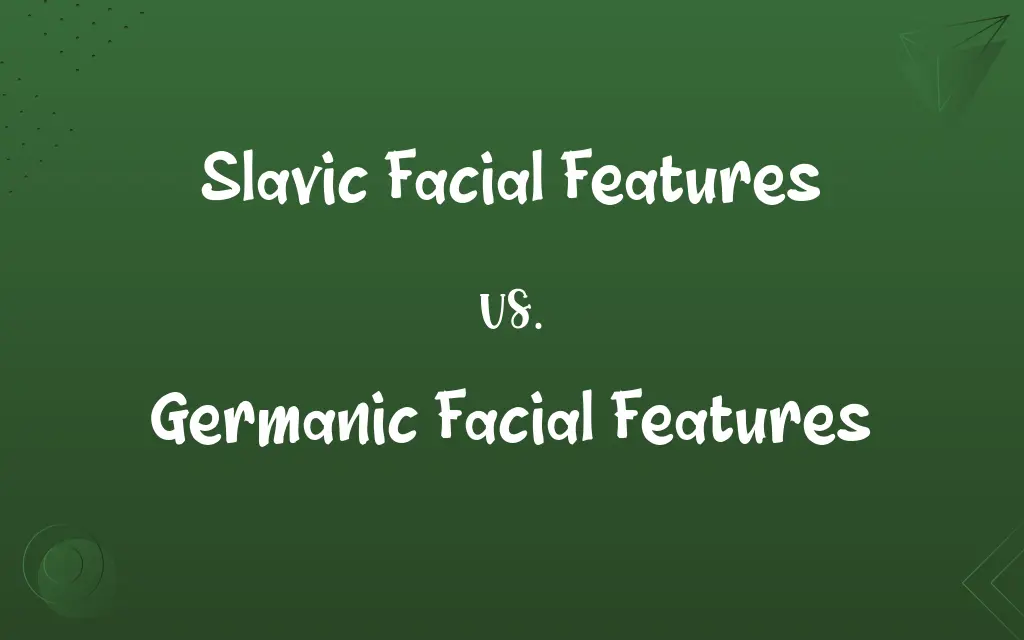Slavic Facial Features vs. Germanic Facial Features: Know the Difference

By Shumaila Saeed || Published on January 31, 2024
Slavic facial features often include high cheekbones and rounder faces, while Germanic facial features typically have sharper angles and stronger jawlines.

Key Differences
Slavic Facial Features are characterized by broader, high cheekbones and rounder face shapes, suggesting a softer appearance. Germanic Facial Features, in contrast, often exhibit more pronounced, angular jawlines and narrower faces, giving a more defined look.
Shumaila Saeed
Jan 31, 2024
The eyes in Slavic Facial Features tend to be wide-set and almond-shaped, often with a noticeable epicanthic fold, adding to the distinctive Slavic look. Germanic Facial Features commonly feature smaller, deep-set eyes, with a wider range of colors including blue and green, which are less common in Slavic populations.
Shumaila Saeed
Jan 31, 2024
In terms of the nose, Slavic Facial Features frequently present with a straight or slightly convex profile and a rounded tip. Germanic Facial Features often have a narrower, sometimes aquiline nose, with a more prominent bridge, adding to their characteristic profile.
Shumaila Saeed
Jan 31, 2024
The lips in Slavic Facial Features are typically fuller and more pronounced, which contrasts with the Germanic Facial Features where the lips are often thinner and less prominent.
Shumaila Saeed
Jan 31, 2024
The skin tone among individuals with Slavic Facial Features tends to be lighter, often with an olive undertone, whereas Germanic Facial Features are associated with a wider range of skin tones, including very fair.
Shumaila Saeed
Jan 31, 2024
ADVERTISEMENT
Comparison Chart
ADVERTISEMENT
Slavic Facial Features and Germanic Facial Features Definitions
Slavic Facial Features
Slavic facial features often include prominent high cheekbones.
Her high cheekbones gave her a classic Slavic appearance.
Shumaila Saeed
Jan 11, 2024
Germanic Facial Features
An aquiline nose with a prominent bridge is often seen in Germanic facial features.
His aquiline nose suggested a Germanic lineage.
Shumaila Saeed
Jan 11, 2024
Slavic Facial Features
Almond-shaped eyes are a distinctive trait of Slavic facial features.
Her almond-shaped eyes were a testament to her Slavic heritage.
Shumaila Saeed
Jan 11, 2024
Germanic Facial Features
Thinner lips are a common aspect of Germanic facial features.
The thinness of her lips was typical of Germanic facial features.
Shumaila Saeed
Jan 11, 2024
Slavic Facial Features
Individuals with Slavic facial features usually have a rounder face shape.
His round face immediately suggested Slavic ancestry.
Shumaila Saeed
Jan 11, 2024
ADVERTISEMENT
Germanic Facial Features
Germanic facial features often include a strong, angular jawline.
His angular jawline was a clear sign of Germanic roots.
Shumaila Saeed
Jan 11, 2024
Slavic Facial Features
A straight or slightly convex nose is typical in Slavic facial features.
His straight nose was indicative of Slavic facial features.
Shumaila Saeed
Jan 11, 2024
Germanic Facial Features
A narrower, more defined face shape is characteristic of Germanic facial features.
Her narrow face was a hallmark of Germanic facial features.
Shumaila Saeed
Jan 11, 2024
Slavic Facial Features
Full, well-defined lips are common in Slavic facial features.
The fullness of her lips was a characteristic of Slavic facial features.
Shumaila Saeed
Jan 11, 2024
Germanic Facial Features
Germanic facial features typically have smaller, deep-set eyes.
His deep-set eyes were a distinctive Germanic trait.
Shumaila Saeed
Jan 11, 2024
Repeatedly Asked Queries
How do Slavic and Germanic eye shapes differ?
Slavic eyes are often wide-set and almond-shaped, whereas Germanic eyes are usually smaller and deep-set.
Shumaila Saeed
Jan 31, 2024
What are the key differences in cheekbones between Slavic and Germanic facial features?
Slavic facial features typically have broader, higher cheekbones, while Germanic features tend to have less prominent cheekbones.
Shumaila Saeed
Jan 31, 2024
What are some typical Slavic facial features?
Common Slavic features include fair to light skin, straight to wavy hair, high cheekbones, and blue or green eyes.
Shumaila Saeed
Jan 31, 2024
Are Slavic facial features distinct from other European features?
Slavic facial features have similarities with other European groups but may have unique characteristics specific to the Slavic population.
Shumaila Saeed
Jan 31, 2024
Are there differences in face shapes between Slavic and Germanic features?
Yes, Slavic features often include a rounder face shape, while Germanic features are more likely to be narrower and more angular.
Shumaila Saeed
Jan 31, 2024
What are the common lip characteristics of Slavic facial features?
Slavic facial features generally have fuller, more pronounced lips.
Shumaila Saeed
Jan 31, 2024
What are Slavic facial features?
Slavic facial features refer to the physical characteristics commonly found among people of Slavic descent.
Shumaila Saeed
Jan 31, 2024
Do all Slavic people share the same facial features?
No, there can be variation within Slavic populations due to historical migrations and intermixing with other ethnic groups.
Shumaila Saeed
Jan 31, 2024
Can Slavic facial features be found outside of Europe?
Slavic facial features are primarily associated with Eastern and Central Europe but can be found in diaspora communities worldwide.
Shumaila Saeed
Jan 31, 2024
Are Slavic facial features influenced by culture?
Culture can influence grooming and adornment choices but generally has a limited impact on inherent facial features.
Shumaila Saeed
Jan 31, 2024
Can you predict someone's ethnicity based solely on their facial features?
It's challenging to predict ethnicity solely based on facial features, as there can be significant overlap between ethnic groups.
Shumaila Saeed
Jan 31, 2024
Are Slavic facial features influenced by genetics?
Yes, genetics play a role in determining Slavic facial features, but environmental factors also contribute.
Shumaila Saeed
Jan 31, 2024
What are Germanic facial features?
Germanic facial features pertain to the physical traits commonly observed among people of Germanic descent.
Shumaila Saeed
Jan 31, 2024
Do Germanic facial features vary across different Germanic subgroups?
Yes, facial features can vary among subgroups like Anglo-Saxons, Scandinavians, and Germans.
Shumaila Saeed
Jan 31, 2024
Do all Germanic people share the same facial features?
No, there can be variation within Germanic populations due to historical migrations and interactions with other ethnic groups.
Shumaila Saeed
Jan 31, 2024
Do Slavic facial features change with age?
Like any other ethnic group, Slavic facial features can change with age due to factors like aging and lifestyle.
Shumaila Saeed
Jan 31, 2024
Are Slavic facial features related to health or personality traits?
Facial features may offer limited insights into an individual's health or personality, but they are not reliable indicators.
Shumaila Saeed
Jan 31, 2024
Are Germanic facial features influenced by genetics?
Genetics play a role, but environmental factors and intermixing with other groups can also affect facial features.
Shumaila Saeed
Jan 31, 2024
Can Germanic facial features be found outside of Europe?
Germanic facial features can be found among descendants of Germanic immigrants in various parts of the world.
Shumaila Saeed
Jan 31, 2024
What are some typical Germanic facial features?
Typical features include fair to light skin, straight to wavy hair, prominent noses, and a variety of eye colors.
Shumaila Saeed
Jan 31, 2024
Share this page
Link for your blog / website
HTML
Link to share via messenger
About Author
Written by
Shumaila SaeedShumaila Saeed, an expert content creator with 6 years of experience, specializes in distilling complex topics into easily digestible comparisons, shining a light on the nuances that both inform and educate readers with clarity and accuracy.








































































